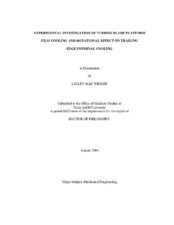| dc.contributor.advisor | Han, Je-Chin | |
| dc.creator | Wright, Lesley Mae | |
| dc.date.accessioned | 2010-01-15T00:14:12Z | |
| dc.date.accessioned | 2010-01-16T02:14:26Z | |
| dc.date.available | 2010-01-15T00:14:12Z | |
| dc.date.available | 2010-01-16T02:14:26Z | |
| dc.date.created | 2006-08 | |
| dc.date.issued | 2009-06-02 | |
| dc.identifier.uri | https://hdl.handle.net/1969.1/ETD-TAMU-1826 | |
| dc.description.abstract | The present work has been an experimental investigation to evaluate the
applicability of gas turbine cooling technology. With the temperature of the mainstream
gas entering the turbine elevated above the melting temperature of the metal components,
these components must be cooled, so they can withstand prolonged exposure to the
mainstream gas. Both external and internal cooling techniques have been studied as a
means to increase the life of turbine components.
Detailed film cooling effectiveness distributions have been obtained on the
turbine blade platform with a variety of cooling configurations. Because the newly
developed pressure sensitive paint (PSP) technique has proven to be the most suitable
technique for measuring the film effectiveness, it was applied to a variety of platform
seal configurations and discrete film flows. From the measurements it was shown
advanced seals provide more uniform protection through the passage with less potential
for ingestion of the hot mainstream gases into the engine cavity.
In addition to protecting the outer surface of the turbine components, via film
cooling, heat can also be removed from the components internally. Because the turbine blades are rotating within the engine, it is important to consider the effect of rotation on
the heat transfer enhancement within the airfoil cooling channels. Through this
experimental investigation, the heat transfer enhancement has been measured in narrow,
rectangular channels with various turbulators. The present experimental investigation
has shown the turbulators, coupled with the rotation induced Coriolis and buoyancy
forces, result in non-uniform levels of heat transfer enhancement in the cooling channels.
Advanced turbulator configurations can be used to provide increased heat transfer
enhancement. Although these designs result in increased frictional losses, the benefit of
the heat transfer enhancement outweighs the frictional losses. | en |
| dc.format.medium | electronic | en |
| dc.format.mimetype | application/pdf | |
| dc.language.iso | en_US | |
| dc.subject | Gas Turbine Heat Transfer | en |
| dc.subject | Forced Convection | en |
| dc.subject | Film Cooling | en |
| dc.subject | Heat Transfer Enhancement | en |
| dc.title | Experimental investigation of turbine blade platform film cooling and rotational effect on trailing edge internal cooling | en |
| dc.type | Book | en |
| dc.type | Thesis | en |
| thesis.degree.department | Mechanical Engineering | en |
| thesis.degree.discipline | Mechanical Engineering | en |
| thesis.degree.grantor | Texas A&M University | en |
| thesis.degree.name | Doctor of Philosophy | en |
| thesis.degree.level | Doctoral | en |
| dc.contributor.committeeMember | Chen, Hamn-Ching | |
| dc.contributor.committeeMember | Lau, Sai | |
| dc.contributor.committeeMember | Schobeiri,Taher | |
| dc.type.genre | Electronic Dissertation | en |
| dc.type.material | text | en |
| dc.format.digitalOrigin | born digital | en |


